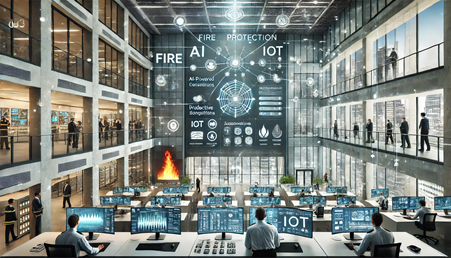
Fire protection systems are critical in safeguarding lives, property, and assets from the devastating impacts of fires. As technology advances and environmental conditions change, it becomes essential to ensure that fire protection systems are not only effective today but also resilient and adaptable for the future. Future-proofing these systems involves integrating advanced technologies, adopting sustainable practices, and anticipating emerging threats to maintain their efficacy and reliability over time.
The Importance of Future-Proofing Fire Protection Systems
- Evolving Fire Risks
Modern buildings and environments are constantly evolving, introducing new fire risks that traditional systems may not effectively address. Factors such as the increased use of synthetic materials, complex building designs, and climate change-induced weather patterns contribute to changing fire dynamics. - Regulatory Compliance
Fire safety regulations and standards are continually updated to reflect new knowledge, technologies, and risks. Future-proofing ensures that fire protection systems remain compliant with evolving legal and regulatory requirements, avoiding costly retrofits or penalties. - Cost Efficiency
Investing in future-proof fire protection systems can lead to significant cost savings in the long term. Advanced systems reduce the likelihood of fire incidents, minimize damage, and lower maintenance and upgrade expenses.
Key Strategies for Future-Proofing Fire Protection Systems
- Integration of Advanced Technologies
- AI and Machine Learning
AI and Machine Learning (ML) technologies are revolutionizing fire detection and response. These systems analyze vast amounts of data from sensors, cameras, and other devices to identify fire hazards, predict fire behavior, and automate responses. AI-powered systems can differentiate between false alarms and real threats, improving accuracy and reducing response times. - Internet of Things (IoT)
IoT-enabled fire protection systems create a network of interconnected devices that monitor and respond to fire hazards in real time. Smart sensors, alarms, and sprinklers communicate with each other, providing comprehensive coverage and faster reaction to potential fires. - Predictive Analytics
Predictive analytics leverages historical data, environmental factors, and building usage patterns to predict fire risks before they materialize. By identifying potential hotspots and vulnerabilities, these systems allow for proactive measures to prevent fires.
- AI and Machine Learning
- Adoption of Sustainable Practices
- Eco-Friendly Materials
Future-proof fire protection systems incorporate sustainable and eco-friendly materials. For example, fire-resistant building materials that emit fewer toxic fumes during a fire not only enhance safety but also reduce environmental impact. - Water Conservation
Modern sprinkler systems are designed to use water more efficiently. Technologies such as water mist systems and smart sprinklers minimize water wastage while ensuring effective fire suppression. - Energy Efficiency
Energy-efficient fire protection systems, such as those using low-power sensors and energy-saving alarm systems, contribute to the overall sustainability of a building.
- Eco-Friendly Materials
- Scalability and Flexibility
- Modular Systems
Modular fire protection systems can be easily expanded or reconfigured to accommodate changes in building layout, usage, or regulations. This flexibility ensures that the system remains effective as the building evolves. - Software Updates
Future-proof systems are designed with updatable software, allowing for the integration of new features, security patches, and compliance with updated standards without the need for extensive hardware replacements.
- Modular Systems
- Enhanced Communication and Collaboration
- Centralized Monitoring
Centralized monitoring systems provide a unified platform for managing fire protection across multiple locations. This approach enables faster coordination, improved data analysis, and more efficient resource allocation during fire incidents. - Emergency Response Integration
Future-proof fire protection systems are integrated with local emergency services, ensuring rapid communication and coordinated responses. Automated alerts, real-time data sharing, and guided evacuation procedures enhance overall emergency management.
- Centralized Monitoring
- Continuous Training and Education
- Training Programs
Regular training programs for building occupants, facility managers, and fire safety personnel ensure that everyone is prepared to respond effectively during a fire emergency. These programs should be updated to incorporate new technologies and best practices. - Awareness Campaigns
Raising awareness about fire safety and the importance of advanced protection systems helps foster a culture of safety. Engaging occupants and stakeholders in fire prevention efforts contributes to a safer environment.
- Training Programs
Challenges in Future-Proofing Fire Protection Systems
- Cost and Investment
The initial cost of implementing advanced technologies and sustainable practices can be high. However, the long-term benefits, such as reduced maintenance costs, improved safety, and compliance, often outweigh the upfront investment. - Technological Complexity
The integration of complex technologies requires specialized knowledge and expertise. Ensuring that fire protection systems are properly installed, maintained, and updated necessitates ongoing training and support from qualified professionals. - Data Privacy and Security
IoT-enabled and AI-powered systems generate and process large amounts of data. Protecting this data from cyber threats and ensuring compliance with privacy regulations is a critical aspect of future-proofing fire protection systems.
The Future of Fire Protection Systems
- Smart Cities and Infrastructure
As smart cities and infrastructure continue to develop, fire protection systems will become more interconnected and data-driven. Integration with city-wide monitoring systems, real-time data sharing, and predictive analytics will enhance fire safety on a larger scale. - Climate-Resilient Systems
Climate change poses new challenges to fire protection, such as increased frequency and intensity of wildfires. Future-proof systems will incorporate climate resilience, adapting to changing environmental conditions and providing reliable protection in extreme weather events. - Personalized Fire Safety
Advancements in AI and data analytics will enable personalized fire safety solutions tailored to individual buildings, industries, and environments. Customizable systems will address specific risks and requirements, ensuring optimal protection.
Conclusion
Future-proofing fire protection systems is essential for adapting to evolving risks, technologies, and regulations. By integrating advanced technologies, adopting sustainable practices, and ensuring scalability and flexibility, organizations can enhance fire safety, protect lives and property, and achieve long-term cost efficiency. As the world continues to change, future-proof fire protection systems will play a crucial role in building resilient and safe communities.





Leave A Comment